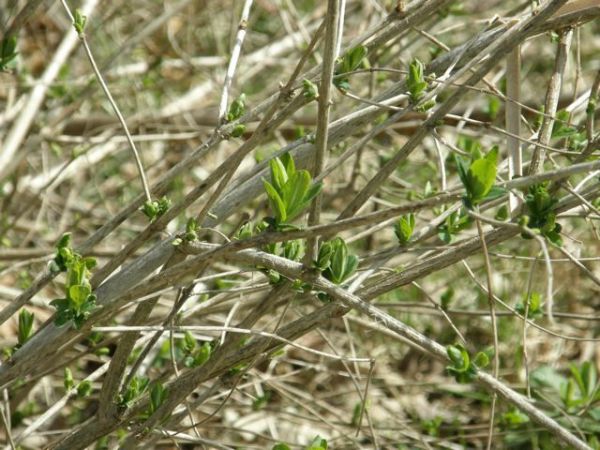
5 April 2011
Here’s a scary thought: Bush honeysuckle increases the risk of tick-borne disease.
It’s not only scary, it’s true!
A team of scientists with tick expert Brian F. Allan from Washington University in St. Louis conducted an extensive study of the relationship between ticks, deer and the invasive plant known as bush honeysuckle.
Though the study was done in the suburbs of St. Louis what they learned applies to Pennsylvania as well. Namely, that in dense stands of bush honeysuckle there are a lot more deer than usual, a lot more ticks than usual, and a higher proportion of the ticks carry disease.
More deer than usual? The researchers ran deer density counts inside and outside the honeysuckle areas. In the honeysuckle zone there were 5 times as many deer.
A lot of ticks? You bet! One of Brian Allan’s tick traps caught 5,000 nymphal stage ticks in a single location. Ticks don’t walk far to get a meal — less than 10 feet — so that spot in the honeysuckle was loaded and dangerous.
Even worse, when they ground up the ticks and tested the mash for bacterial and deer DNA, they discovered that ticks found inside the honeysuckle zone were 10 times more likely to carry bacterial disease than those outside — and they caught it from deer blood.
So why do deer like honeysuckle so much?
People used to think that deer liked honeysuckle for its berries but the researchers proved the deer don’t care about the fruit. Deer hang out in the honeysuckle because it provides great cover. It’s 18% denser than our native vegetation and it’s first to leaf out in the spring (it’s the only green shrub right now) and it’s last to lose leaves in the fall. Deer love it. They sleep there.
The result is that you’re much more likely to catch a tick-borne disease if there’s a lot of bush honeysuckle around. In Missouri you’ll catch Ehrlichiosis, in Pennsylvania, Lyme disease.
Bush honeysuckle is everywhere, especially in parks and gamelands.
But there’s one positive take-away. This news may prompt people to try harder to eradicate bush honeysuckle — and that would make our native plants very happy.
Read more about the study in this October 12, 2010 article in Science Daily. Don’t miss Brian Allan’s description of his tick trap.
(photo of bush honeysuckle leaves in the Spring by Marcy Cunkelman)
Lyme’s disease has puzzled me for years now. In New Jersey according to the CDC as of 1999, 25% of nymphs and 50% of adult deer ticks carry Lyme’s. Knowing how easy it is to for a human to “get” a visible (ie. lonestar or dog tick) tick, it must be as easy to “get” the less visible deer tick. Given the level of exposure for most outdoorsy people, I would figure that just about everyone of my friends should have Lyme’s by now. So far, I do not know anyone personally who has been diagnosed. I wonder if there are other unknown factors which aid in the transmission, genetic vulnerabilty for instance. I believe that Lyme’s exists. Among other strategies, I try to stay out of leaf litter in the spring and brush in the fall. I try to stick to the middle of wide paths as I do not wish to contract Lyme’s. However, I wonder if these and other restrictions I put I my activities are necessary. Most people do not use any precautions and most people have, so far, not contracted Lyme’s. What does anyone else think?
Umm . . . not to sound disparaging, but I wouldn’t worry too much about this. As long as you steer clear of honey suckle you shouldn’t be affected, and if honeysuckle is irradiated, the deer will find some other dense bush to sleep in and the ticks will follow them there. Saying that honeysuckle causes more ticks is like saying that low laying areas cause more water, it’s just were they tend to collect. As far as getting rid of an invasive species, on the other hand, go for it.
Yes, it’s a mystery where ticks are & where they aren’t. The only non-mystery is that they’d be where deer sleep => bush honeysuckle.
I hike a lot & sometimes bushwhack (when acting as a Land Steward I had to bushwhack to check the boundaries). In my travels I’ve found places that are tick-infested beyond anything I can stand: the Belle Plain State Forest in NJ and a place on the Clarion River in Jefferson County near Hidinger Rd where I used to be a Land Steward for WPC. I have no explanation for the infestations as those two places. They were so infested that people who lived there kept guinea fowl (they eat ticks).
In spring-summer-fall, I always wear long light-colored pants and (when off-trail) I pull my socks over the bottoms of my pants. I check my clothes religiously over & over while I’m in the field. I HATE ticks.
Predictable places to find them: In my experience they are off trail, in brushy places, often near a stream. If I see a tick on my pants I know that it’s a site where I can NEVER SIT DOWN. All the other precautions are fine but if you sit down where there are ticks, all bets are off.
>Saying that honeysuckle causes more ticks is like saying that low laying areas cause more water, it’s just were they tend to collect.
True!
Funny that you mention sitting down. I’ve also noted that sitting down is the surest way to attract attention from the meal-searching set.
If you want to know where to ticks hang out, just ask my dog. I can’t think of a time we went on a hike with her that she didn’t get ticks! Also, interestingly enough, she has contracted lyme’s disease, which causes her to limp sometimes. She seems to be doing just fine otherwise.